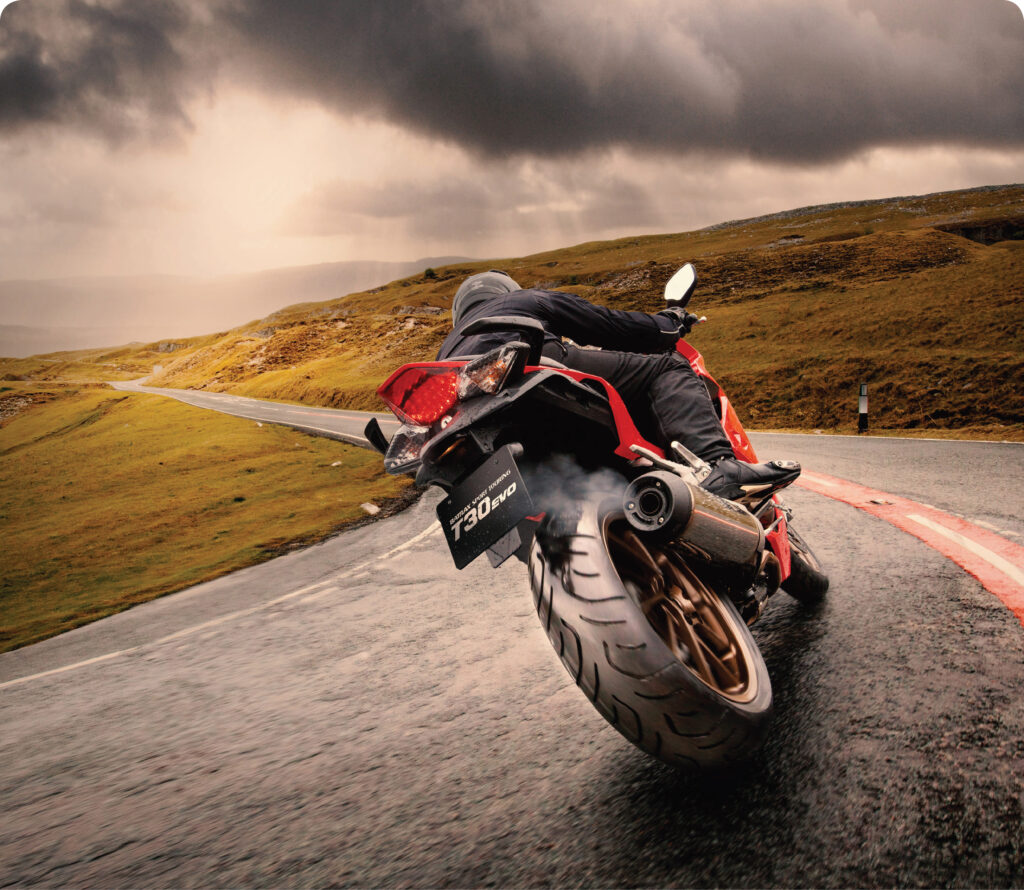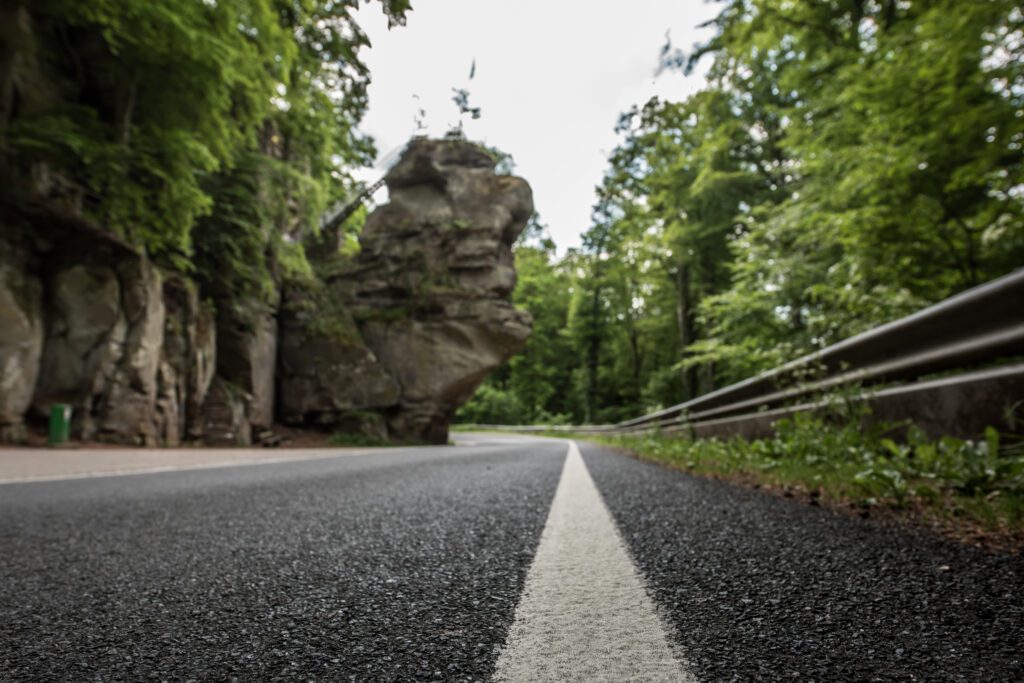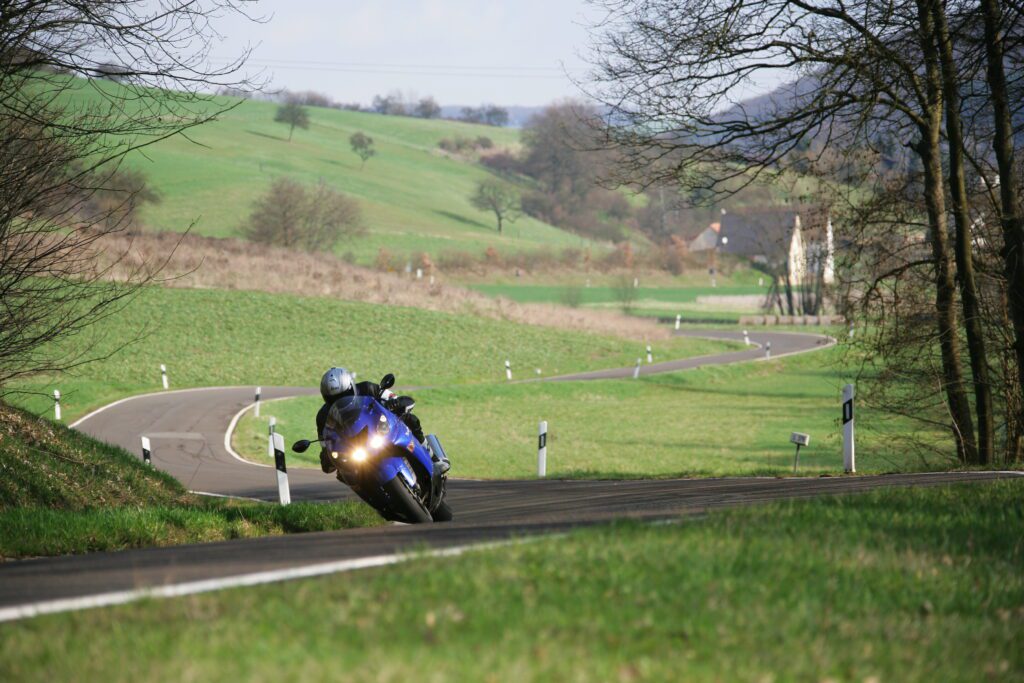We ride on them, our tyres stick to them and our bikes lean on them – literally.
But we never stop to wonder where they came from, where they’re going, and what they’re made of.
Text: Simon Hargreaves Pictures: Simon Hargreaves, Bridgestone
Everyone who rides a bike instinctively knows a pair of fresh, correctly inflated tyres are vital. Without them, your bike’s grip is compromised, and grip is what stops a moving motorcycle – and you – falling over. But grip works two ways – tyres will only stick to something if that same something sticks back to them (if you want to prove this, take the stickiest road tyres you can find and go for a ride on wet grass). And the thing that tyres like sticking to the most, is called a road.

The history of roads
Roads were invented during the agricultural revolution 12,000 years ago when early humans stopped hunting and gathering, and settled down to live in caves. Clearing a route between your cave and your neighbour’s cave made popping round for dinner or going shopping much easier. These early trackways were fine on foot, and were gradually widened to make room for livestock with the introduction of animal farming around 8000 BC. But when the wheel was developed as a means of transport, around 4000 BC, roads had to develop too.
The earliest dirt roads were simply tracks cleared down to the topsoil. Soon, different materials were used to strengthen the road – wood, gravel, stone slabs – but, apart from some notable exceptions such as a 50km paved road built by the Minoans of Crete in 2000 BC, it wasn’t until the Roman army started marching and pulling chariots all over Europe that the need for strong, reliable, weatherproof roads arose. With a network covering tens of thousands of miles, Roman roads used several layers to build strength, starting with a base layer of sand or light gravel, followed by larger rocks (sometimes set in mortar), a lighter layer of smaller or crushed stone, with a top layer of paved stone blocks. Ditches were dug on either side and the top layer cambered to aid drainage, pedestrian areas were built, and milestones used to mark distance. These innovations are still used today.
When the Romans withdrew, the roads fell in disrepair (although many of the routes and much of the actual construction remains today). Without a coherent force to maintain the roads, it wasn’t until the 18th century that systematic road construction began again in Europe. However, around the world, road development continued; in the Middle East, the Arab Empire began using a sticky binding substance, derived from oil, to bind and seal the top layer of their most prestigious roads. The substance was called tar.
In the early 19th century a Scotsman called John McAdam developed a cheaper, quicker road-building technique which no longer needed large base layers of stone, but relied on compacting the existing subsoil and using fine control of smaller stone sizes to maintain the road’s integrity. The method was popular until the invention of motorised vehicles in the early 20th century, when higher speeds meant dust and wear became a problem. It was solved by spreading molten tar mixed with sand on the road surface, to seal the top layer. Tarmac was born.
What’s in a modern road?
Tar has long been replaced by bitumen (or asphalt), also a by-product of refining oil, because it’s more stable across a wider range of temperatures and easier to manage.
The basic ingredients of a modern asphalt road (also called blacktop, or pavement) are only a few main materials: an aggregate (stone particles, typically gravel or granite) mixed with a bitumen binder, and fillers. There are numerous mixes, variants and grades, modified by adding chemicals (polymers, fibres, waxes, zeolites and emulsions) to tailor them to the specific weather and traffic conditions of the country or location where they’ll be used.
In practice this means there are literally thousands of possible ‘recipes’ of what we think of as the layers of asphalt on, and in, a road. But, generally, the layers are made up, top to bottom, something like this:
• Surface Course – the top layer we ride over. Has to be noise and skid resistant, durable against rutting, cracking and wear in all weather. Typically it’s made from HRA (hot rolled asphalt), which is a mixture of around 6 – 8% asphalt with, for example, up to 14mm maximum grain size chips of granite or gravel. The layer is usually around 30 – 50mm thick.
• Binder Course – this layer, also made from HRA, gives structural stability, especially on rural roads where no lower structural layers may exist. Made from similar materials as the Surface Course, mixed in different ratios with larger-sized aggregate, around 20mm max. Usually 60 – 90mm thick.
• Base Course – again, made from HRA and for structural stability on main, trunk and industrial roads, and motorways. Aggregate size is larger still, ordinarily up to 35mm. The layer is usually 90 – 130mm thick.
• Sub-Base – this is the main foundation of a road. It’s typically made up with an unbound aggregate (granite or limestone) with specification and layer thickness dependent on the category of road and the underlying soil conditions, but often around 350mm.
• Capping Layer – similar to the sub-base, but often a lower-spec material. Typically 150 – 350mm thick.
• Geotextile Membrane – a permeable mat made from synthetic fabric that stops the layers above it merging with the subsoil.
• Sub-Grade – measured for its load-bearing and stability, then consolidated and compacted, this is the natural bottom layer.

What’s the difference between road types?
The construction of a road is governed by the soil conditions in the area, the anticipated frequency of use (measured in millions of standard axles), the range of vehicles that will use it (obviously larger vehicles like HGVs, busses etc will stress a road more than cars and bikes), its design life (typically 40 years in Europe) and, finally, the cost of construction.
Roads are normally categorized as:
• Unclassified (rural/residential)
• Residential or industrial
• Main roads (principal routes)
• Side roads (lower category routes)
• Trunk roads and motorways

A trunk road or motorway will be built to the highest standard possible and costs the most. Principal routes can also be constructed to a similar specification and are often maintained by a national body rather than local councils. Non-trunk road roads, side roads and below are looked after by local highway authorities. Because of their lower use, these are designed and maintained to a lower, less expensive standard. With all roads, the type and speed of the traffic also determines the best surface in terms of skid resistance. Trunk roads and motorways will get a better product and increased skid resistant surfaces, but lesser roads can demand it if the environment dictates (accident black spots, the approach to pedestrian crossings, entrance to roundabouts or outside schools, or on very sharp bend etc).
Cost plays a major role in determining the specification of a road. It’s entirely possible to build roads that never wear out, never suffer from pot-holes, and will never need maintenance in a lifetime. However, the cost of materials and scale of the engineering make it impractical.
Why can’t all roads be surfaced like race tracks?
Shell Cariphalte Racetrack is an asphalt with a modified bitumen binder used in high performance locations, such as race tracks. Many MotoGP circuits (not Silverstone though) use this stuff. It’s very stiff and resistant to stress, fretting (which is general surface wear and tear) and deformation. It also provides very high grip. The reason it’s not used on roads is simple; its specialist contents and specific construction requirement means it costs many, many times more than a normal road – and, frankly, that kind of performance simply isn’t required by most vehicles.

How long does it take to build a road and what does it cost?
How long is a road? The duration of construction varies by on type and size of the road, so can be anything from a few months to up to three years. Tests are regularly carried out during construction to ensure the materials conform to specification and performance needs. When the road is finished, it’s normal for the client (the local authority or national body) to withhold a percentage of the costs for a year. This is called a ‘defects correction period’ and is a kind of road-repair warranty.
The cost of a road also depends the category of road, and can be between 1300 euros to 11,000 euros, or more, per metre. The manpower used also, of course, depends or the type of road and the contractor. Around 20 men would be involved in building a minor road, but that can rise to a few hundred on a motorway – and some works are so substantial an entire community of Porta-cabins means the workforce can live on site.
How many different types of surface are there?
Thousands, and as many companies making them. There are standards they must conform to in use, and standards in terms of the type, size and ratios of aggregate used, but manufacturers will use different additives and other compounds to create their specific blends.
Shell Grip is a popular type of high grip surface many of us might have heard of. We usually think of it as the sandy-coloured, textured surface on the approach to roundabouts or used on hairpins. It’s a high-friction, anti-skid material using a calcined bauxite aggregate with an epoxy or polyurethane resin to give a skid resistance value (SRV) of 70+. Skid resistance is measured using a special machine called a SCRIM (Sideways Force Co-efficient Routine Investigation Machine) – it’s a special test wheel, angled at 20 degrees, towed behind a car at 50kph.
But Shell Grip, and the many other surface coatings like it, are – you guessed it – expensive. Again, it comes down to a balance between the type of use, road life and cost.

Why resurface roads with gravel chippings?
The bottom line is it’s cheap, effective in terms of prolonging the road surface’s life and, providing you ride according to the recommended speed limit (usually 30kph), not dangerous to you or your bike, say road planners. They say the problems come when people ride too fast and they either skid on the loose gravel or their front tyre flicks a stone through their radiator. Or another vehicle speeds and flicks a stone at you, smashing a headlamp or chipping your paintwork. But this is not always the case; even at low speed a bike can lose control on gravel – to say nothing of cleaning the sticky tar-like bitumen off your bike afterwards.
Why do pot-holes and bumps appear?
Pot holes are caused by the ingress of water into the road. Good drainage is vital to a road’s longevity – water will erode, corrode (in the case of road salt) and generally break down road layers. Or, as is the case in some countries, winter weather cycles that involve repeated freezing (expansion) then thawing (contraction), will quickly break and collapse sections of road. And as long as traffic still runs over the damage, it gets worse.
As for bumps, they’re caused by poor soil conditions, tree roots, or bad road design and construction; for example on the entrances to sharp bends where heavy braking by large vehicles will ripple the road surface, or wear grooves with repeated use. But, generally, when a road surface ages and wears, the asphalt binder deteriorates which leaves the exposed, abrasive aggregate – which then becomes over-polished and slippery.





